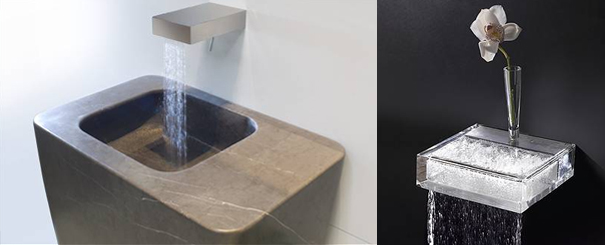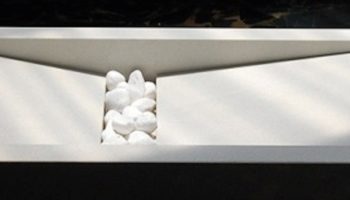At Salone: Chorus by Toscoquattro
If you’re in the market for Tuscan minimalism, look no further than manufacturer Toscoquattro’s Chorus bathroom series by Claudio Nardi, on display this week at Salone del Mobile in Milan.
Chorus bathroom series. Designed by Claudio Nardi. Manufactured by Toscoquattro.
Though many of Nardi’s designs hearken back to a vaunted Italian history of forging elegant and functional shapes from stone, he’s intrigued by innovation as well. In fact, a cornerstone of his design philosophy is the interaction between innovation and history–how new materials and new ideas about (or constraints upon) space influence the execution of old technique. With his bathroom designs for Toscoquattro, Nardi seems preoccupied with the ways in which surfaces embrace or eschew the elements acting upon them. Each element of Chorus is chosen to particular effect, to how its unique texture and tone respond to whatever may be playing upon it, whether light, water, or air.
Chorus is a concerto of wood, stone, and steel–materials that are not always complementary and that are difficult to integrate in a bathroom scheme. Basin and bathtub are made of monolithic Antalya grey stone, the hollowed space that creates its function conceived as “a sinuous curved void extending into the space until it disappears inside the stone, no sharp edges, no sudden changes to block the play of light upon the surface.” This attention to fluid transitions gives the tub and basin an aura of mystery; especially when filled with water, the curved surfaces vanish into a trick of perspective–one cannot tell whether the container’s end is just beneath the surface –and the water a mere filament, gliding across the stone as a trickling stream across a river rock; or fathoms deep–and the water untold gallons, filling the contours of imperceptible subterranean depths.

Just as the stone controls the water, the wall vanity controls the light. Constructed of heavily lacquered golden toned Mongoy, the glassy surface of the cabinetry complements–even as it contradicts–the receptive quality of the basin and tub. While the surafces are texturally similar to one another, the wood’s heavy gloss and autumnal palette makes it first and foremost a reflective device. Contrary to the stone, light is not swallowed within its cavities but rather harnessed and projected, illuminating everything within its purview, giving the piece an impenetrable quality that its functionality belies.
Lastly, the shelving system, a series of geometric knives’ edges emerging seamlessly from the wall, provides the closing modulation to this overture. Like the vanity and tub, the shelves project an inviting tactile smoothness coupled with a forbidding aspect–in this case, the blade-like expanse and ultra-thin profile creating an illusion of fragility.
As a whole, Nardi’s Chorus defines itself through a dialectics of opposition–between texture and form, the visible and the hidden, receptivity and repulsion. The interplay between embracing and containing, on the one hand, and rejecting and reflecting, on the other, gives the ensemble a notable identity, employing a variety of elemental materials to celebrate the often contradictory qualities of light, air, and water.




Leave a Reply